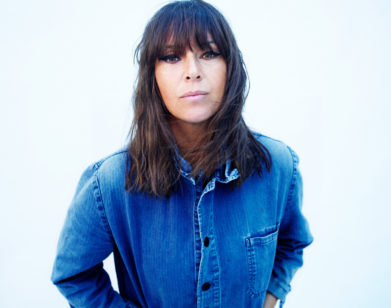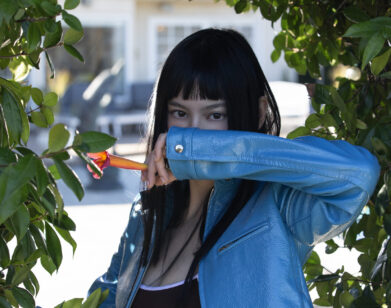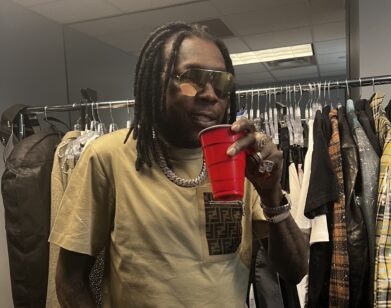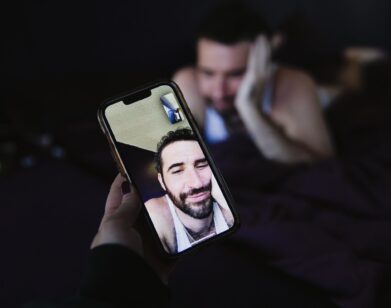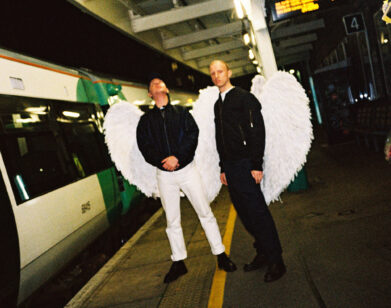EMO
American Football on Their Accidental Midwestern Legacy
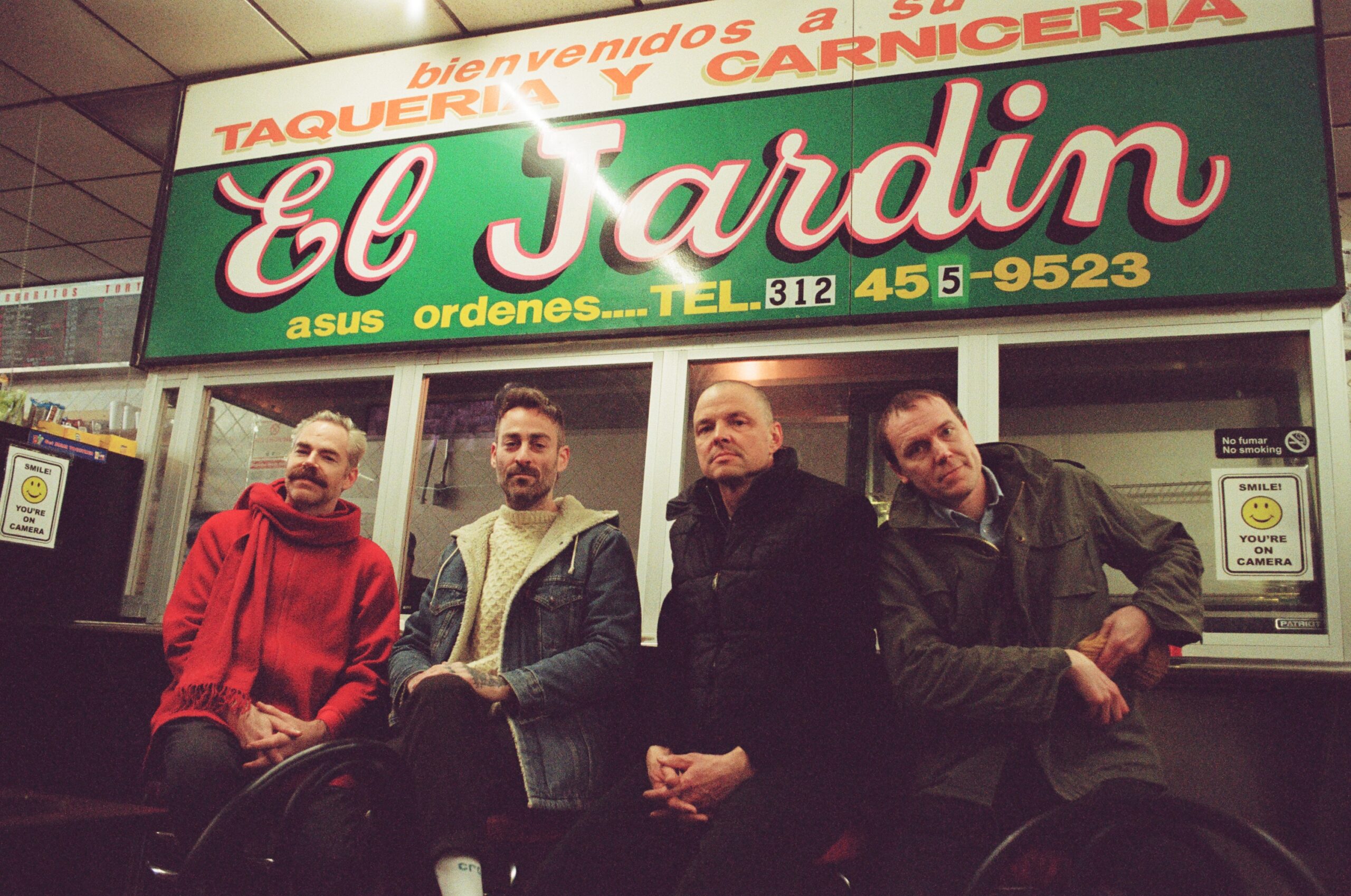
American Football, photographed by Alexa Viscius.
———
JULIAN RIBEIRO: Hi guys, how are you?
MIKE KINSELLA: Hi, all good.
STEVE HOLMES: What’s happening, Julian? Nice to meet you.
RIBEIRO: It’s nice to meet you guys too, dude. I was on a really long car ride the other day and I re-listened to the album. I was really feeling the vibes. Congratulations on 25 years.
KINSELLA: I feel like it’s been 50 years. It feels like a different lifetime.
RIBEIRO: Totally. How was it to go back to the album and that time?
KINSELLA: It’s funny, 25 years later and we’re finally getting good at playing these songs. Not to be a crab, it’s not the thing that I wake up wanting to do. It’s sort of lower on the list, but it’s insane that anybody still cares or talks about it.
HOLMES: It’s kind of crazy, too, because the idea for the Covers record was an off-the-cuff thing that came up at the end of the LP3 tour. Then the pandemic hit and we were on hiatus. [Steve] Lamos was like, “I’m going to retire from the band for now.” He had stepped away and then this idea came back because we were like, “Well, the band’s sort of on hold.” So we had this as a placeholder project before Lamos would hopefully come back and we’d pivot back to LP4. Then last year we got back together. We knocked the rust off, did some shows, played some in countries we’d never been to. It feels like it’s been a really long time since we’ve been able to put out new music. Even the reissue came out later because we didn’t know that Polyvinyl was going to find the tapes and that we would actually be able to remaster it.
RIBEIRO: I can only imagine. What was that like, to arrange a whole remaster for this album?
HOLMES: Most of us had nothing to do with it. Matt [Lunsford] from Polyvinyl found the tapes basically in a box that was sealed up 15 or 20 years ago. What he found was the DAT tape master, which was used to remaster the album originally. But not the ADAT tapes, which would be the original master tapes where you could remix it. So we could remaster it, but you still can’t remix that album. The mix is sort of set in stone.
KINSELLA: There was the whole conversation about, “Oh, turn my vocal sound on this one spot.” And it was like, “No, you can’t. We can’t fix it.”
HOLMES: Yeah, the mix is the mix. But it could be remastered. They had to get these old tape machines to even try to get the music off of it. I think one or two tracks wouldn’t work and they had to get five of these machines before they could download all of the digital software.
RIBEIRO: Younger people have a pretty narrow understanding of the technical making of these kinds of things, because so much music today exists only as a WAV file. Now it’s just kids rapping into their phone mic and put it–
HOLMES: Into their laptop. Yeah, it’s crazy.
RIBEIRO: But it’s so cool that you guys were able to figure it out and come back together. To talk about Covers for a second, I was really interested in how you curated the artists who participated on the record.
KINSELLA: Well, it starts out with a list. Everybody throws ideas around and then the list gets curated. And it’s so fun to have a younger ear to the ground, our manager, because everything gets put through her filter. She’s like, “This isn’t cool, blah, blah, blah.” We try to reach out to people–we had some no’s, we had some yeses, and then we went from there.
HOLMES: From the inception to it coming out was five years. But it was probably two years of our management company and the label doing all this back and forth behind the scenes and us not having anything to do other than saying, “Yeah, we like that artist.” It’s amazing that they pulled it off. There was a little drama. The first artist, who was the most famous and shall remain nameless, dropped out at the last minute. But eventually it worked out.
RIBEIRO: It’s really a feat to get that many different people at different career stages into the studio. How is it looking back on the visual legacy of this album 25 years later? I had this conversation with my boyfriend while we were driving and I was playing the album because he didn’t know it. But he was like, “Oh, I know that image.” It’s like a Yellow Submarine level image–people don’t know what it is, but they’ve seen it.
KINSELLA: And just like Yellow Submarine, people know, “This is something my dad likes.”
HOLMES: It’s funny. When we first got back together in 2014, that was the first time I heard anyone ever say album artwork was iconic. I thought they were making fun of us. I was like, “Really? Iconic?!” But I’ve come to realize that it is a thing. People love the house. We retroactively tried to figure out why this became that. We weren’t really a band originally, so there was very little documentation of us, hardly any photos or videos. We lived in the pre-internet world, so I think that image was something that people clung onto as the one iconography of the band. I also think it’s kind of the perfect Petri dish for stuff to happen, too. So many people have added and done different stuff with it, so it’s very funny how enduring that kind of thing can be. I was thinking, too, about how the album was recorded in four days. Was it?
KINSELLA: Allegedly. Nobody really knows. We all have different memories of how long it was. Probably four or five days.
RIBEIRO: In a pre-internet and pre-streaming world, that’s a really crazy thing. Do you guys have any thoughts on the revival of emo music for young people? Because it’s bigger than it’s ever been right now.
HOLMES: I believe it. When we got back last year, playing shows for the first time after a three-year hiatus, we were like, “Do people still care about this band?” We’d roll up to the venue to soundcheck hours before the show and there’d be 15 or 20 high school kids lined up for autographs. We were like, “That didn’t used to happen.” So it doesn’t surprise me that there’s a big emo scene with teenagers. There’s always that scene of punk kids. We were those punk kids when we were that age, and it seems like a perpetual self-generating thing that always exists. There are always the weirdo outsiders that are making artsy, punk rock music, and I’m glad that we have anything to do with that still.
RIBEIRO: Maybe at that age, you guys had albums that you would look at like, “This is my shit. This record made me think about music more critically.” Your record is that record for much more than just the emo or indie kids. Are you guys excited about bringing the show on the road? I’m going to come to the Warsaw one. My friends, Hello Mary, are opening.
HOLMES: Oh, we were just with them in the U.K. They’re the best.
KINSELLA: It’s so fun to do this in relation to what you were saying about emo, punk, screamo, or whatever scene these kids are getting into. That was us too, there was never any aspiration of being successful or making money. You just thought you’re going to sing and yell about what you were feeling at that moment. It’ll pass, and then you grow up or something. It’s funny to be adults and literally singing about the same stuff. The shows are great.
HOLMES: When the band first got back together in 2014, we did the first run of reunion shows on the 15th anniversary. I hadn’t been in a band in a decade, that was my first time on stage and it took a minute. When I look back at those performances, I can tell I was nervous. But now that we have a decade of experience behind us, we’re a dramatically better band. Mike Garzon, who’s our guitar tech, is now basically in the band and plays guitar on some songs. He’s amazing and we couldn’t do it without him. And Corey Bracken, who’s our vibraphone player, has been with us since LP2. So now it just feels like we’re such a more cohesive unit. I feel like we’re actually a real band now. And like you were saying, weirdly, the band is more popular than it’s ever been at this moment. In London, we just played the biggest headline show we’ve ever played in our careers. People have come and gone along the way, but it keeps resonating with young generations of fans who weren’t there 10 years ago. Kids who are 16 to 20 are like, “We couldn’t have seen you in 2014.” They’re getting to see us this time.
RIBEIRO: I’m 25, which means the record’s only a few months younger than I am. I mean, they wouldn’t have let me in a venue in 2014 because I was 14.
HOLMES: There you go.
RIBEIRO: Also, it’s interesting because it’s happening post-TikTok. My youngest sibling is 17, and he is talking about shit and showing me music and references, and I’m like, “How?” It’s like time is so flat to kids because they’ve been on the internet the whole time. This album and an album that came out yesterday or 100 years ago, that’s not that different because they just interact with it in the same way.
KINSELLA: Yeah, you would go record shopping and know not only the songs but the year they came out. Like, “Oh, that’s old Iron Maiden and this is new,” because I remember buying the records. Watching my kids now, there’s so much happening. Does that make stuff more or less precious? I don’t know.
RIBEIRO: I guess it makes stuff less precious, because the mode of consumption has changed along with the mode of discovery.
KINSELLA: For the younger kids at the show, they don’t know the difference between our band and our story and how we got to be at a sort of large music venue. It reads like they think we’re celebrities or something, and that wasn’t part of our scene at all. We’re kind of like, “What the fuck?” I want to squash that probably too much, but I’m not going to be able to teach kids why celebrity culture is bad by making a flippant statement. But I don’t think it’s good for kids. I just took my daughter to a concert and she’s so excited about these very mundane things. In the opening band, the guy would do a little spin and everybody loses their mind. I’m like, “He’s just playing music.”
RIBEIRO: My little brother, he’s probably been seeing memes about the house for eight years. He’s like, “These guys must be fucking crazy vibes.”
KINSELLA: We made the record a long time ago, but at the time we were just into music. And now you can equate hearing a song on TikTok or a meme to being famous. But it doesn’t mean that. And if they are famous, they might not be rich. There’s a million indie bands that you hear of all the time and they’re in your algorithm, but they’re not making any money. They’re not playing big rooms.
HOLMES: Yeah, we live in weird times where bands can be TikTok famous or Instagram famous, but they can’t actually sell tickets. There’s a weird dichotomy between having a following–
KINSELLA: Or they can be TikTok or Instagram famous or whatever and sell a wild amount of tickets–
HOLMES: And can’t perform.
KINSELLA: They have no talent or thing to sell except that they’re a celebrity. I don’t want to encourage that with my kids, anyway.
HOLMES: It’s weird times. And back to Mike’s point, we came up in such a DIY underground scene that we made this record completely in a vacuum. We documented it as, “Here’s a thing that existed for the 1,000 people that might give a shit.” And we broke up because we were graduating and going back home and going our separate ways at that time in our lives. I would’ve never even considered being in a band as a career. Bands were on major labels or thought they could be famous or be on the radio. We just didn’t care about that.
KINSELLA: Every band we knew that would’ve wanted to get to the level that we just fell into now, 25 years later, they signed to a major label and got eaten up, just fucked. If the record wasn’t an immediate hit, they got ignored. They had to recoup the money before they ever saw a dime.
HOLMES: And we saw that, right? Bands that we looked up to.
KINSELLA: Oh, many times.
HOLMES: Like Shudder to Think.
KINSELLA: And Jawbreaker.
RIBEIRO: So many deals have been inked in the last five years for internet artists that have massive advances and records that need to be made. I think the next version of that reckoning is coming for some people, because the industry has changed faster than contracts can keep up.
KINSELLA: I don’t know. Billie Eilish, wasn’t she just recording at home in her bedroom and became this huge pop star? I mean, that’s kind of awesome. You can’t necessarily replicate it unless you have the talent or the money, but a million people will try. It changes music and how it’s made. We’re constantly like, “We’re a band that existed 25 years ago in this way,” and then we had to relearn how to be a band that existed 10 years ago.
RIBEIRO: 100%. In my mind, I’m like, “2014, was it that long ago.” But actually, everything has kind of changed since then.
KINSELLA: Trump didn’t exist as a political figure and the Cubs hadn’t won a World Series. Everything coming out of COVID–kids are weirder, adults are weirder. It changed the way people think about leaving the house and engaging socially. Everybody was already on their phone, but you really kind of became addicted to a sort of fake internet relationship. Anyway, I don’t know what we’re talking about. COVID changes everything, being in a band changes everything, our awareness changes everything. Trying to do the same thing that we did in a vacuum 25 years ago– now in front of more people than we’ve ever done it before–it’s kind of a mind-fuck.
RIBEIRO: Our time is almost up. I’m going to ask a terrible question. If someone younger than me is starting a band, do you have any advice or wisdom to pass on to them?
KINSELLA: They should write the “Never Meant” riff.
HOLMES: I would say just listen broadly, listen to everything. Have a very wide musical palette and do what you think is cool, that’s all you can do. If you’re excited about it and you think it’s good music, then hopefully somebody else will. Don’t try to catch a wave. Who cares what anyone else would like?

